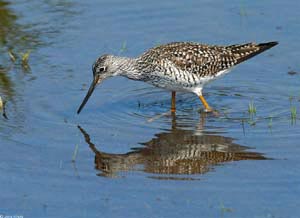 Mostly marsh and forested wetland, Ellis Bay is a 3,200-acre wet wonderland. It is perfect habitat for ducks and wading birds, like herons and egrets. White-tailed deer and many other wildlife species also use the area. To protect Chesapeake Bay wetlands, this area was purchased by the Maryland Department of Natural Resources in 1957 and has been offering outdoor and nature enthusiasts recreational opportunities ever since.
Mostly marsh and forested wetland, Ellis Bay is a 3,200-acre wet wonderland. It is perfect habitat for ducks and wading birds, like herons and egrets. White-tailed deer and many other wildlife species also use the area. To protect Chesapeake Bay wetlands, this area was purchased by the Maryland Department of Natural Resources in 1957 and has been offering outdoor and nature enthusiasts recreational opportunities ever since.
What To See
Ellis Bay WMA is best seen by boat. Boat ramps, including one located on the property and others located nearby, provide convenient access. The many creeks that dissect the marsh offer views into the lives of the marshlands wildlife. Herons and egrets can be observed as they stalk their favorite fish. Between April and September, you may see the glossy ibis probing its long bill into the mud for small worms and crustaceans. Bald eagles soar overhead in search of a meal, while barn owls nest in boxes provided for them in the marsh.
What To Do
Hunters will find white-tailed deer, squirrels, woodcock, ducks, Canada geese and cottontail rabbits. Trapping is offered by yearly lease. Anglers and seafood lovers will enjoy crabbing and fishing for trout, white perch and rockfish. A boat ramp makes it easy for boaters to hit the water. Mosquitoes and other biting insects can be a problem from spring through early fall. Bring insect repellent, minimize exposed skin and wear light-colored clothing.
Area Regulations
- Use of Ellis Bay WMA is generally permitted seven days a week throughout the year.
- Hunting is allowed in accordance with open seasons and shooting hours.
- All State and Federal Hunting Laws and Regulations are applicable.
- Trapping is by permit only.
- No motorized vehicles are allowed.
Non-hunting Users Guide
- Non-hunting visitors are welcome.
- Be aware of open hunting seasons and visit accordingly.
- Season dates available in newspapers, on the Internet, and at some area stores.
- Trails are maintained and suitable for hiking, nature photography, birding, hunting and other recreational activities, but are not actively marked.
Site Management Goals
- Nest boxes for Barn Owls have been erected to supplement natural tree cavities for nesting.
- Tidal marsh habitat conditions on the WMA limit management practices that can be implemented.
 Directions
Directions
Ellis Bay WMA is located in southwestern Wicomico County on Muddy Hole Road. From U.S. 50, take MD 349 west to Capitola Road, south to Trinity Church Road, west to Muddy Hole Road and Ellis Bay WMA. Marked parking areas located off Muddy Hole Road. Boat access: via Nanticoke, Ellis Bay WMA, and Mt. Vernon public boat ramps. For additional information contact the LeCompte Work Center at (410)376-3236.
 Click Here for Map
Click Here for Map
Photograph of Greater Yellowlegs Courtesy of John White.
This area is a part of Maryland’s Department of Natural Resources public land system and is managed by the Wildlife and Heritage Service. The primary mission of the WMA system is to conserve and enhance wildlife populations and their respective habitats as well as to provide public recreational use of the State’s wildlife resources.
Eighty-five percent of the funding for Maryland's state wildlife programs comes from hunting license fees and a federal excise tax on sport hunting devices and ammunition. The federal aid funds are derived from the Federal Aid in Wildlife Restoration (or Pittman-Robertson) Fund, which sportsmen and women have been contributing to since 1937. Each state receives a share of the funds, which is administered by the U. S. Fish and Wildlife Service; these funds are used for wildlife conservation and hunter education programs, including the management of the WMA system.
Other sources of funds for land acquisition include Program Open Space Funding for Maryland's State and local parks and conservation areas, provided through The Department of Natural Resources' Program Open Space. Established in 1969, Program Open Space symbolizes Maryland's long-term commitment to conserving natural resources while providing exceptional outdoor recreation opportunities.